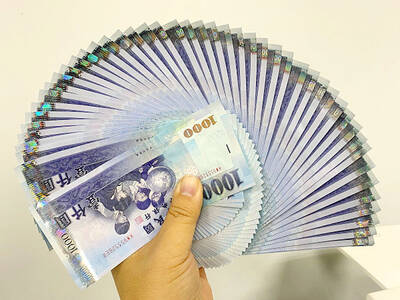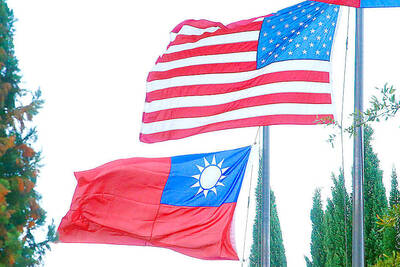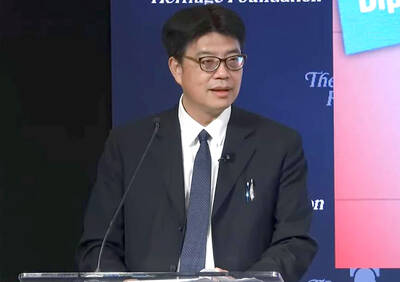Taiwan yesterday signed a far-reaching free-trade agreement (FTA) with Singapore — the first of its kind with a Southeast Asian country — in a move the government said would boost the nation’s efforts to pursue further economic engagement with trading partners bilaterally and multilaterally.
“This is a milestone achievement for Taiwan’s progress toward economic liberalization and our participation in regional economic integration,” Minister of Economic Affairs Chang Chia-juch (張家祝) told a press conference at 11am in Taipei.
Minister of Foreign Affairs David Lin (林永樂) said the agreement demonstrated Taiwan’s commitment to trade and investment liberalization to the global community.

Photo: Pichi Chuang, Reuters
The agreement “serves as an example” for Taiwan’s negotiation with other countries to sign economic cooperation agreements, Lin said.
“It could also trigger a domino effect” by encouraging other countries to open talks with Taiwan on similar trade accords, Lin added.
The pact — called the Agreement between Singapore and the Separate Customs Territory of Taiwan, Penghu, Kinmen and Matsu on Economic Partnership (ASTEP) — was signed by Representative to Singapore Fadah Hsieh (謝發達) and Singaporean Trade Representative to Taiwan Calvin Eu at a ceremony held at 9:30am in Singapore.
With Beijing’s insistence that FTAs can only be concluded among sovereign states, Taiwan has to conclude FTA-like agreements under a different name, such as the Agreement between New Zealand and the Separate Customs Territory of Taiwan, Penghu, Kinmen and Matsu on Economic Cooperation signed in August.
The exceptions are the four FTAs that Taiwan has with five diplomatic allies in Central America — Panama, Guatemala, Nicaragua, El Salvador and Honduras.
Billed by the government as a comprehensive, “high-standard” and “high-quality” trade agreement, the ASTEP contains 17 chapters, covering market access conditions for trade in goods, cross-border trade in services, government procurement and e-commerce; issues related to trade rules — technical barriers to trade, rules of origin, foreign investment, competition policies, trade remedies, customs procedures, sanitary and phytosanitary measures, and transparency; cooperation in intellectual property protection; and dispute settlement provisions.
Taiwan will remove 99.48 percent of its tariff lines within 15 years at the latest, with the exception of 40 agricultural products, including rice, mangoes, garlic, shiitake mushrooms, red beans, shelled ground-nuts and liquid milk.
Once the agreement takes effect, expected early next year, Taiwan will provide Singapore immediate tariff-free access to 65.97 percent of its agricultural products and 87.39 percent of its industrial products, while duties on the rest of the products will be reduced in three stages over a 15-year period.
The tariff cuts will have a limited impact on Taiwan’s agricultural sector because Singapore is not an agriculture-based economy, he said.
Chang added that throughout the two-and-a-half years of negotiations, Taiwan pressed for a longer tariff phase-out period to give less-competitive, domestic-oriented industries, such as auto parts, engines, motorcycles, towels and cotton clothing, time to adjust.
In return, Singapore, which has a very open trading regime that levies tariffs on only six beverage products, extended zero tariffs to all imports from Taiwan.
Both countries also agreed to adopt a “negative list” — as opposed to the “positive list” used in the WTO’s General Agreement on Trade in Services — to provide greater market access to investors from the other country. Under this set-up, the two countries agreed to open all their service sectors, unless specifically excluded by each country in an annex to the agreement.
Taiwan’s negative investment list covers 30 sectors in transportation, telecommunication and professional services, while Singapore has 35 sectors on its list related to healthcare and transportation, among others.
Both countries agreed to go beyond their respective WTO commitments in certain service sectors, including research and development service, general engineering and Type I telecommunications enterprises, while applying their commitments under the WTO to the finance industry under the bilateral agreement.
The agreement is expected to add US$701 million to Taiwan’s GDP over the next 15 years, boosting domestic output by NT$42.1 billion (US$1.43 billion) and creating 6,154 jobs, Chang said, citing a study conducted by the Chung-Hua Institution for Economic Research (中華經濟研究院).
Lin said that aside from signing FTAs with its main trade partners, Taiwan’s ultimate goal is to participate in regional economic integration through agreements such as the Trans-Pacific Partnership (TPP) and the Regional Comprehensive Economic Partnership (RCEP) — both possible pathways to the formation of an Asia-Pacific free-trade area.
“We will contact each member involved in TPP and RCEP negotiations and conclude agreements with them one by one,” Lin said.
Taiwan has completed feasibility studies on signing FTA-like pacts with India and Indonesia. Another one on trade with the Philippines is expected to be completed in the near future, Lin said.

Taiwan is projected to lose a working-age population of about 6.67 million people in two waves of retirement in the coming years, as the nation confronts accelerating demographic decline and a shortage of younger workers to take their place, the Ministry of the Interior said. Taiwan experienced its largest baby boom between 1958 and 1966, when the population grew by 3.78 million, followed by a second surge of 2.89 million between 1976 and 1982, ministry data showed. In 2023, the first of those baby boom generations — those born in the late 1950s and early 1960s — began to enter retirement, triggering

ECONOMIC BOOST: Should the more than 23 million people eligible for the NT$10,000 handouts spend them the same way as in 2023, GDP could rise 0.5 percent, an official said Universal cash handouts of NT$10,000 (US$330) are to be disbursed late next month at the earliest — including to permanent residents and foreign residents married to Taiwanese — pending legislative approval, the Ministry of Finance said yesterday. The Executive Yuan yesterday approved the Special Act for Strengthening Economic, Social and National Security Resilience in Response to International Circumstances (因應國際情勢強化經濟社會及民生國安韌性特別條例). The NT$550 billion special budget includes NT$236 billion for the cash handouts, plus an additional NT$20 billion set aside as reserve funds, expected to be used to support industries. Handouts might begin one month after the bill is promulgated and would be completed within

NO CHANGE: The TRA makes clear that the US does not consider the status of Taiwan to have been determined by WWII-era documents, a former AIT deputy director said The American Institute in Taiwan’s (AIT) comments that World War-II era documents do not determine Taiwan’s political status accurately conveyed the US’ stance, the US Department of State said. An AIT spokesperson on Saturday said that a Chinese official mischaracterized World War II-era documents as stating that Taiwan was ceded to the China. The remarks from the US’ de facto embassy in Taiwan drew criticism from the Ma Ying-jeou Foundation, whose director said the comments put Taiwan in danger. The Chinese-language United Daily News yesterday reported that a US State Department spokesperson confirmed the AIT’s position. They added that the US would continue to

IMPORTANT BACKER: China seeks to expel US influence from the Indo-Pacific region and supplant Washington as the global leader, MAC Minister Chiu Chui-cheng said China is preparing for war to seize Taiwan, Mainland Affairs Council (MAC) Minister Chiu Chui-cheng (邱垂正) said in Washington on Friday, warning that Taiwan’s fall would trigger a regional “domino effect” endangering US security. In a speech titled “Maintaining the Peaceful and Stable Status Quo Across the Taiwan Strait is in Line with the Shared Interests of Taiwan and the United States,” Chiu said Taiwan’s strategic importance is “closely tied” to US interests. Geopolitically, Taiwan sits in a “core position” in the first island chain — an arc stretching from Japan, through Taiwan and the Philippines, to Borneo, which is shared by